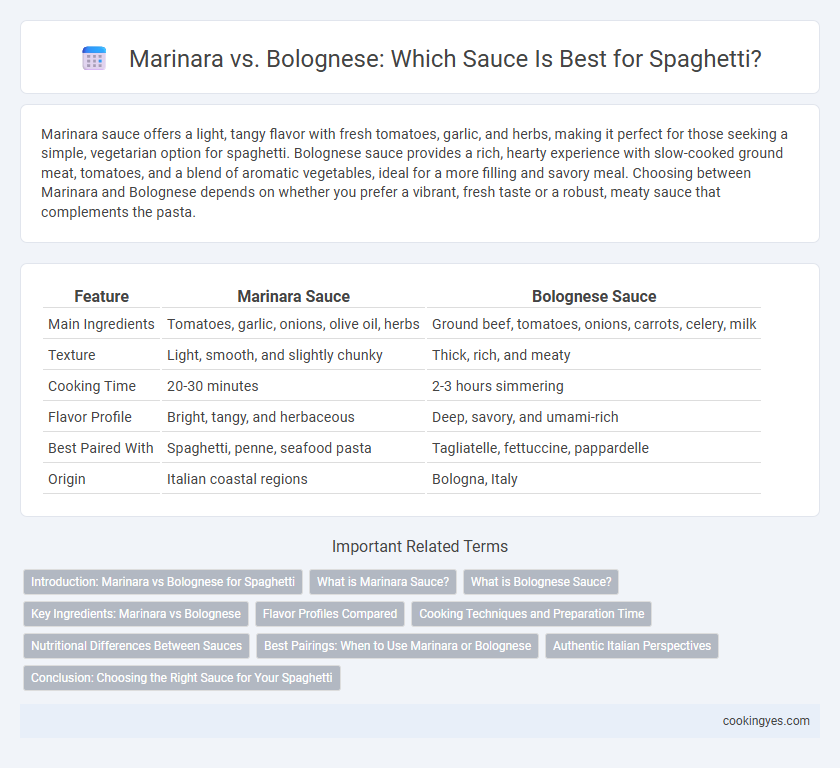Marinara sauce offers a light, tangy flavor with fresh tomatoes, garlic, and herbs, making it perfect for those seeking a simple, vegetarian option for spaghetti. Bolognese sauce provides a rich, hearty experience with slow-cooked ground meat, tomatoes, and a blend of aromatic vegetables, ideal for a more filling and savory meal. Choosing between Marinara and Bolognese depends on whether you prefer a vibrant, fresh taste or a robust, meaty sauce that complements the pasta.
Table of Comparison
| Feature | Marinara Sauce | Bolognese Sauce |
|---|---|---|
| Main Ingredients | Tomatoes, garlic, onions, olive oil, herbs | Ground beef, tomatoes, onions, carrots, celery, milk |
| Texture | Light, smooth, and slightly chunky | Thick, rich, and meaty |
| Cooking Time | 20-30 minutes | 2-3 hours simmering |
| Flavor Profile | Bright, tangy, and herbaceous | Deep, savory, and umami-rich |
| Best Paired With | Spaghetti, penne, seafood pasta | Tagliatelle, fettuccine, pappardelle |
| Origin | Italian coastal regions | Bologna, Italy |
Introduction: Marinara vs Bolognese for Spaghetti
Marinara and Bolognese sauces represent distinct Italian culinary traditions for spaghetti toppings, each offering unique flavors and textures. Marinara is a simple, tomato-based sauce with garlic, herbs, and olive oil, delivering a light and tangy complement to pasta. Bolognese, a meat-based ragu made from ground beef, pork, or veal simmered with tomatoes, onions, and wine, provides a rich and hearty option for a more substantial spaghetti dish.
What is Marinara Sauce?
Marinara sauce is a simple, tomato-based Italian sauce made from fresh tomatoes, garlic, onions, and herbs such as basil and oregano, typically simmered quickly to preserve a vibrant, tangy flavor. It is naturally vegetarian and light, often used as a versatile sauce for spaghetti, pizza, and seafood dishes. Unlike the meat-rich Bolognese, marinara emphasizes bright, fresh, and aromatic ingredients, making it a staple in Mediterranean cuisine.
What is Bolognese Sauce?
Bolognese sauce, originating from Bologna, Italy, is a rich meat-based sauce typically made with ground beef or pork, tomatoes, onions, carrots, celery, and a splash of wine or milk for depth. Unlike marinara, which is a light, tomato-centric sauce, Bolognese is slow-cooked to develop a thick, hearty texture ideal for spaghetti. This sauce emphasizes savory flavors and protein, making it a robust choice for pasta dishes seeking a more substantial, satisfying meal.
Key Ingredients: Marinara vs Bolognese
Marinara sauce features key ingredients like crushed tomatoes, garlic, onions, olive oil, and fresh herbs such as basil and oregano, giving it a light, tangy, and vibrant flavor profile. Bolognese sauce combines ground beef or pork, soffritto (onions, carrots, celery), tomato paste, milk or cream, and red wine, creating a rich, hearty, and savory meat-based sauce. The fundamental difference in key ingredients defines Marinara as a fast, vegetarian-friendly sauce, while Bolognese offers a slow-cooked, protein-rich option ideal for a robust spaghetti dish.
Flavor Profiles Compared
Marinara sauce offers a bright, tangy flavor dominated by fresh tomatoes, garlic, and aromatic herbs like basil and oregano, creating a light and vibrant complement to spaghetti. Bolognese sauce presents a rich, savory taste with slow-cooked ground beef, carrots, onions, and celery, enhanced by tomato paste and a touch of cream or milk, resulting in a deeply satisfying, meaty flavor. The contrast between Marinara's fresh acidity and Bolognese's hearty umami makes each sauce uniquely suited to different pasta experiences.
Cooking Techniques and Preparation Time
Marinara sauce requires quick sauteing of garlic, onions, and tomatoes, typically simmered for 20 to 30 minutes to enhance fresh flavors. Bolognese involves slow-cooking ground meat with vegetables, wine, and broth over several hours, allowing deep, rich flavors to develop. The shorter preparation time of marinara contrasts with the extended simmering essential for a traditional Bolognese, affecting texture and taste complexity.
Nutritional Differences Between Sauces
Marinara sauce, primarily made from tomatoes, garlic, and herbs, is lower in calories and fat while providing a rich source of vitamins A and C as well as antioxidants like lycopene. Bolognese sauce, containing ground meat, onions, and cream or milk, offers higher protein and fat content along with essential nutrients like iron and vitamin B12. Choosing between marinara and bolognese affects not only flavor but also macronutrient balance and micronutrient intake in a spaghetti meal.
Best Pairings: When to Use Marinara or Bolognese
Marinara sauce, made from tomatoes, garlic, and herbs, pairs best with light spaghetti dishes or seafood, enhancing fresh and vibrant flavors. Bolognese, a rich meat-based sauce featuring ground beef, pork, and soffritto, complements hearty spaghetti recipes, adding depth and richness to the meal. Choose marinara for quick, simple meals and bolognese for slow-cooked, comforting dishes that require a robust sauce.
Authentic Italian Perspectives
Authentic Italian perspectives distinguish Marinara as a simple, tomato-based sauce infused with garlic, onions, and herbs originating from Naples, often used for quick meals and seafood dishes. Bolognese, or Ragu alla Bolognese, hails from Bologna and features a slow-cooked blend of ground meat, soffritto, tomato paste, and wine, creating a rich, hearty sauce traditionally served with tagliatelle rather than spaghetti. True Italian cuisine adheres to regional pairings, emphasizing the freshness of ingredients in Marinara and the depth of flavor in Bolognese, reflecting distinct culinary traditions rather than a one-size-fits-all approach.
Conclusion: Choosing the Right Sauce for Your Spaghetti
Marinara sauce offers a light, tomato-based flavor ideal for a quick, vibrant spaghetti dish, while Bolognese provides a rich, meaty texture perfect for a hearty, slow-cooked meal. Selecting between Marinara and Bolognese depends on whether you prefer a fresh, tangy taste or a savory, protein-packed experience. Understanding these distinct sauce characteristics ensures the perfect pairing for your spaghetti preferences.
Marinara vs Bolognese for spaghetti sauce Infographic

 cookingyes.com
cookingyes.com